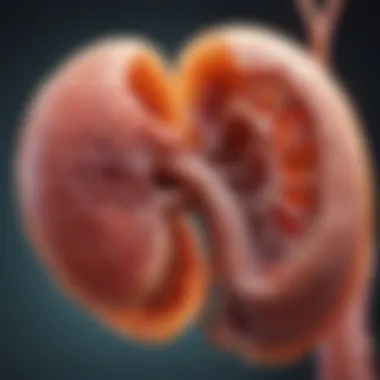Comprehensive Management of Polycystic Kidney Disease


Intro
Polycystic kidney disease (PKD) presents a significant challenge in the realm of nephrology. The condition's hereditary nature means that it impacts families over generations, leading to nephron damage and eventual renal failure. This article will delve into the various facets of managing PKD, emphasizing the need for a comprehensive and multidisciplinary strategy.
Recent Advances
Latest Discoveries
Recent research has shed light on the genetic underpinnings of PKD. Studies have identified specific gene mutations associated with the disease, particularly in the PKD1 and PKD2 genes. Understanding these mutations has opened avenues for potential gene therapy approaches. Early detection of these genetic markers can significantly alter patient management, allowing for proactive interventions that may delay the progression of the disease.
Moreover, the exploration of biomarkers that track cyst growth and kidney function is ongoing. For instance, measuring serum creatinine and other nephrotoxins can offer insights into kidney function and help guide treatment decisions.
Technological Innovations
Technological advancements have not only enhanced diagnostic capabilities but also improved treatment efficacy. Imaging techniques such as MRI and ultrasound have become essential in monitoring the progression of cysts in PKD patients. These tools allow for more precise evaluations of kidney size and function, effectively guiding clinical decisions.
Also, the advent of telemedicine has provided new avenues for patient management, especially during the ongoing challenges posed by global health crises. Remote monitoring of kidney health and regular consultations have become part of routine care, ensuring continuous patient support.
"Understanding the genetic basis of PKD opens doors for innovative treatment strategies that can change patient outcomes dramatically."
Management Strategies
Lifestyle Modifications
Adopting a healthy lifestyle is paramount for patients with polycystic kidney disease. Recommendations include:
- Dietary Changes: A low-sodium diet can help manage blood pressure. Reducing protein intake is also beneficial in preserving kidney function.
- Regular Exercise: Physical activity can help maintain a healthy weight, contributing to overall kidney health.
- Hydration: Staying well-hydrated is essential for kidney function and helps manage cyst formation.
Pharmacological Interventions
Medications play a crucial role in managing symptoms and complications in PKD. Common pharmacological strategies include:
- Hypertension Management: Angiotensin-converting enzyme (ACE) inhibitors like lisinopril are often prescribed to manage high blood pressure.
- Pain Management: Nonsteroidal anti-inflammatory drugs (NSAIDs) may be used to relieve pain caused by cysts.
Consultation with a nephrologist to tailor a medication regimen is essential.
Surgical Options
In cases where cysts cause significant pain or complications, surgical interventions may be necessary. Options vary from cyst aspiration to nephrectomy in severe cases. Timely surgical consultation is important when symptoms arise.
Closure
Preface to Polycystic Kidney Disease
Polycystic kidney disease (PKD) is an important health concern that affects many individuals worldwide. Understanding the key aspects of this condition is crucial as it impacts renal function and overall quality of life. A comprehensive overview of PKD provides insight into its management strategies, allowing healthcare professionals to make informed decisions in their practice.
Recognizing the symptoms and implications of PKD is essential for early diagnoses and timely intervention. The relevance extends not just to affected individuals but also to families, healthcare providers, and researchers. Several factors linger when discussing PKD, including its genetic basis, clinical manifestations, and the psychosocial impact on patients.
The focus on a multidisciplinary approach is pertinent. This encompasses regular monitoring, dietary management, pharmacological therapies, and necessary surgical interventions. Each of these elements plays a role in managing the disease effectively and holistically.
In this section, the groundwork will be laid for subsequent discussions on definitions, classifications, epidemiology, and what PKD means in a broader healthcare context.
Pathophysiology of PKD
Understanding the pathophysiology of polycystic kidney disease (PKD) is crucial for managing this genetic condition effectively. This knowledge can aid healthcare professionals in tailoring treatment plans that address both the symptoms and the underlying causes. PKD mainly results from genetic mutations, which leads to anomaly in renal tubules and cystic growth.
Genetic Basis
PKD is primarily linked to mutations in two key genes: PKD1 and PKD2. The PKD1 gene is associated with autosomal dominant PKD, while PKD2 is linked to a milder form of the disease. The mutation in these genes disrupts normal renal function, causing the kidneys to proliferate cysts rather than healthy tissues. These cysts are fluid-filled sacs that, over time, can lead to significant kidney enlargement and dysfunction. Individuals with a family history of PKD many times require genetic testing for risky variants in these genes. This can provide valuable information for early diagnosis and management plans.
Cyst Formation Mechanism


The mechanism behind cyst formation in PKD is complex and involves multiple biological pathways. Initially, the genetic mutations can cause abnormal cell signaling, particularly in renal tubular epithelial cells. The disruption in signaling pathways contributes to increased cell proliferation and fluid secretion. As the cysts grow, they exert pressure on surrounding kidney structures, leading to hypertension and reduced kidney function. Research indicates that the role of cyclic AMP (cAMP) is significant here; elevated levels of cAMP promote cyst growth and fluid retention.
Ongoing research is aimed at understanding these mechanisms more deeply, particularly potential therapeutic targets to mitigate cyst growth and preserve kidney function. Targeting the mechanisms of cyst formation may lead to more effective management strategies.
Understanding the pathophysiology provides a crucial foundation for developing targeted therapies and interventions for PKD, emphasizing the need for informed clinical approaches.
In summary, the pathophysiology of PKD revolves around the genetic factors influencing kidney structure and function. Attention to genetic screenings and ongoing research into the mechanisms can aid not only in diagnosis but also in creating innovative therapies that address the root causes of the disease.
Clinical Manifestations
The clinical manifestations of polycystic kidney disease (PKD) are crucial in understanding how this condition affects patients. Through recognizing various symptoms and complications, both healthcare providers and patients can better manage the disease. The clinical presentation provides insights into the disease progression and informs treatment decisions. Addressing symptoms early can enhance quality of life and potentially delay the onset of severe complications.
Common Symptoms
PKD commonly presents with a range of symptoms. Many patients may experience the following:
- Abdominal Pain: Discomfort in the abdomen often arises from the stretching of the renal capsule as cysts develop.
- Hypertension: Elevated blood pressure is a frequent issue, as PKD affects the kidneys' ability to regulate fluid balance.
- Blood in Urine: Hematuria can occur, indicating potential complications such as cyst rupture.
- Frequent Urination: Especially noticeable at night, a symptom reflecting kidney dysfunction.
- Kidney Stones: Patients are prone to developing kidney stones, leading to additional pain and urinary issues.
Recognizing these symptoms is essential for prompt intervention. Moreover, patients should monitor changes diligently and report any new symptoms to healthcare providers.
Complications Associated with PKD
Polycystic kidney disease can lead to various complications, which may significantly impact a person's health. Some notable complications include:
- Chronic Kidney Disease (CKD): As cysts proliferate, renal function declines, eventually leading to kidney failure.
- Cysts in Other Organs: PKD is not limited to the kidneys. Cysts can also appear in the liver, pancreas, or even the reproductive organs, causing additional complications.
- Urinary Tract Infections (UTIs): Due to structural changes in the kidneys, individuals may face a higher risk of UTIs.
- Aneurysms: Cerebral aneurysms can occur, especially in patients with a family history of vascular diseases.
"Understanding the clinical manifestations and possible complications of PKD allows for proactive management, significantly influencing patient outcomes."
Evaluating these complications is critical for creating an effective treatment plan. Regular follow-ups and monitoring can help anticipate these issues and address them before they escalate.
Diagnosis of Polycystic Kidney Disease
Diagnosis of Polycystic Kidney Disease (PKD) is a critical step in the management of the disorder. Early and accurate diagnosis can significantly influence the treatment plan and overall patient outcomes. In individuals with PKD, failure to diagnose may lead to uncontrolled progression of the disease, ultimately resulting in renal failure and other complications. There are two major components in the diagnosis of PKD: imaging techniques and genetic testing. Both elements play crucial roles, providing vital information that guides treatment strategies.
A correct diagnosis involves not just identifying the presence of cysts but also understanding their implications on kidney function and the patient’s health. This process can help in explaining the symptoms, risk factors, and expected outcomes associated with the disease. The importance of this topic cannot be overstated, as it lays the foundation for a patient’s management trajectory.
Imaging Techniques
Imaging techniques are foundational in diagnosing PKD. They help visualize cysts in the kidneys, corroborating the clinical symptoms presented by the patient. Common imaging modalities include ultrasound, computed tomography (CT) scans, and magnetic resonance imaging (MRI).
- Ultrasound: This is often the first test performed. It uses sound waves to create images of the kidneys, allowing for the detection of cysts. Standard criteria suggest that multiple cysts in both kidneys make the diagnosis of autosomal dominant PKD very likely.
- CT Scans: These provide more detailed images and can detect smaller cysts that may not be visible on ultrasound. CT scans are particularly useful in evaluating kidney volume and complications.
- MRI: Magnetic resonance imaging is highly effective for diagnosing PKD, especially in distinguishing between cysts and solid masses. This is critical given that solid lesions may require a different therapeutic approach.
Imaging can also help in regular monitoring and assessing the progression of the disease, as changes over time can inform treatment decisions.
Genetic Testing
Genetic testing offers another layer of precision in diagnosing PKD. This process assesses specific gene mutations, such as PKD1 and PKD2, that cause the disorder. Knowledge of the genetic basis can help in confirming a diagnosis, especially in cases where imaging results may be inconclusive.
Benefits of genetic testing include:
- Identifying At-Risk Individuals: If a family member has PKD, genetic testing can reveal whether others in the family may carry the gene, even if they do not show symptoms.
- Guiding Treatment Decisions: In some cases, genetic information can inform the choice of therapies and lifestyle modifications, tailored to the individual’s specific condition.
- Understanding Prognosis: Genetic testing can provide insights into the likely progression of the disease, based on the identified mutations.
Diagnostic processes play a crucial role in enabling a comprehensive approach to managing Polycystic Kidney Disease.
Monitoring Disease Progression
Monitoring disease progression in polycystic kidney disease (PKD) is crucial for assessing renal health and planning appropriate therapeutic strategies. PKD often leads to gradual decline in kidney function characterized by the growth of cysts. Early identification of worsening conditions allows for timely interventions, thereby potentially delaying the progression to end-stage renal disease. Regular monitoring informs not just the clinicians but also patients about changes in kidney health, empowering them to participate in their own care.
Key aspects of monitoring include regular assessments and using specific biomarkers. These can reveal how well kidneys are functioning or if complications are developing. Understanding the nuances of these elements encourages more proactive management. It can also enhance patient satisfaction by providing a clearer picture of treatment effectiveness and necessitated adjustments.
"Regular monitoring can mitigate the long-term impact of PKD on quality of life."
Regular Assessments


Regular assessments play a pivotal role in the management strategy for PKD. These assessments typically encompass a series of tests and evaluations designed to track kidney function over time.
- Routine Blood Tests: Tests often focus on serum creatinine levels, which serve as a proxy for kidney efficiency. Elevated levels may indicate declining function, prompting closer monitoring or intervention.
- Blood Pressure Monitoring: Patients frequently experience hypertension. Regular monitoring assists in managing blood pressure effectively, which is integral for preserving kidney function.
- Urinalysis: Regular urinalysis can yield essential information about kidney health, such as proteinuria, which may indicate glomerular damage.
Furthermore, the frequency of these assessments usually depends on the stage of the disease. In the early stages, assessments might be less frequent, whereas those experiencing rapid progression may require bi-annual or even quarterly evaluations. Adapting the frequency ensures that health care resources are utilized appropriately while still safeguarding patient well-being.
Biomarkers of Kidney Function
Biomarkers provide valuable insight into kidney function in individuals with PKD. These indicators can help predict disease progression and determine the effectiveness of ongoing management strategies.
Several key biomarkers include:
- Cystatin C: This biomarker helps assess renal function, especially when creatinine levels may be misleading. It is useful in earlier detection of kidney decline.
- NGAL (Neutrophil Gelatinase-Associated Lipocalin): Elevated levels of NGAL can signal acute kidney injury, making it a critical biomarker for rapidly changing conditions.
- Albuminuria: The presence of albumin in urine can highlight kidney damage and risk of cardiovascular events.
Incorporating these biomarkers into routine assessments can enhance the understanding of a patient’s condition. As new research emerges, additional biomarkers may be identified, potentially enriching the current approaches to monitoring PKD. Regular discussions with healthcare providers about the significance of these indicators are vital for effective disease management.
Management Strategies
Management strategies for polycystic kidney disease (PKD) are crucial for optimizing patient outcomes. The aim is not only to alleviate symptoms but also to slow disease progression. A thoughtful approach encompasses pharmacological therapies, dietary changes, and lifestyle adjustments. Each component serves to maintain kidney function, manage complications, and enhance the quality of life for patients.
Pharmacological Approaches
Antihypertensives
Antihypertensives are vital in managing hypertension associated with PKD. Elevated blood pressure can hasten kidney damage, making blood pressure control a key priority. Antihypertensive medications, such as lisinopril or losartan, help regulate the cardiovascular system, providing safety in long-term renal health. Their use is widely accepted because they are effective and relatively well-tolerated by patients. Nevertheless, attention must be given to individual responses to these medications as side effects, such as dizziness or fatigue, may occur.
Pain Management
Pain management is often overlooked in PKD treatment but is essential. Patients may experience flank pain due to cysts. Nonsteroidal anti-inflammatory drugs (NSAIDs) can provide relief, though they should be used judiciously due to potential kidney impacts. Acetaminophen is an alternative that generally has fewer renal effects. Effectively addressing pain contributes to a better quality of life, which is fundamental in chronic conditions like PKD.
Specific Renal Therapies
Specific renal therapies target the underlying issues of PKD. Medications like tolvaptan have received attention for their potential to slow cyst growth. This drug acts on vasopressin receptors and can delay kidney function decline. However, monitoring for liver function is necessary, as it can lead to increased liver enzymes in some cases. The promise of such therapies underlines the importance of personalized care plans tailored to the patient's unique situation.
Dietary Modifications
Low-sodium Diets
Low-sodium diets are integral for patients with PKD, as sodium can elevate blood pressure and cause fluid retention. Limiting sodium intake can reduce hypertension and decrease the risk of cardiovascular complications. Foods high in salt, such as processed foods, should be avoided. Nutrition education and meal planning can empower patients, creating awareness about healthy choices and ultimately promoting better renal function.
Hydration Strategies
Maintaining proper hydration is essential for kidney health. Adequate fluid intake helps dilute urine and may prevent cyst formation. Encouraging patients to drink sufficient water is critical, though it must be personalized to their medical needs. Hydration strategies can include tracking fluid intake and adjusting levels based on activity or climate conditions. Hydration is a simple yet effective approach in the holistic management of PKD.
Lifestyle Changes
Exercise Regimens
Regular exercise is advocated for its numerous health benefits. In PKD management, exercise can control weight and improve heart health. Moderate aerobic activities like walking or cycling are often recommended, being mindful of individual fitness levels. Encouraging physical activity helps mitigate obesity, which is linked to worsened kidney function. The advantages of an active lifestyle far outweigh drawbacks when adequately supervised and adapted to the patient.
Stress Management
Chronic stress may exacerbate disease progression. Implementing stress management techniques, such as mindfulness and yoga, can help patients face daily challenges. These strategies contribute to overall well-being, which is vital for coping with chronic illness. Each individual requires a personalized approach that fits their circumstances, making stress management a vital component of PKD care.
Overall, comprehensive management strategies enhancing patient involvement are crucial in PKD treatment.
Recognizing and addressing the multifaceted aspects of PKD enables a robust management plan that can significantly improve the quality of life, while potentially delaying renal decline.
Interventions for Advanced Disease
Dialysis Options


Dialysis serves as a vital intervention for patients whose kidneys can no longer perform adequately. It acts to remove waste products and excess fluid from the blood, helping to maintain homeostasis. There are two main types of dialysis: hemodialysis and peritoneal dialysis.
- Hemodialysis involves the use of a machine to filter blood outside of the body. It usually happens in a dialysis center several times a week. Hemodialysis can offer effective waste removal but may also lead to fluctuating energy levels and time constraints.
- Peritoneal dialysis is performed by filling the abdominal cavity with a special fluid that absorbs waste products. This method can be done at home and offers greater flexibility.
Patients must consider their lifestyle, preferences, and the nature of their health when choosing between these dialysis types. Each option has its advantages and challenges, thus a thorough discussion with healthcare providers is essential.
A well-considered approach can enhance life quality in patients undergoing dialysis, balancing medical needs with personal preferences.
Kidney Transplantation
Kidney transplantation is often regarded as the definitive treatment for end-stage renal disease caused by PKD. It offers the possibility of improved kidney function, often restoring normal or near-normal quality of life. When considering transplantation, various factors come into play:
- Donor Options: Patients have the choice of receiving a kidney from either a living donor or a deceased donor. Living donor transplants typically have better outcomes.
- Eligibility Assessment: Not all patients are suitable candidates for a transplant. Factors such as age, overall health, and the presence of other medical conditions are evaluates.
- Post-operative Care: After a transplant, patients will need to take immunosuppressive medication to prevent organ rejection. Regular follow-up appointments are essential to monitor kidney function.
While kidney transplantation significantly enhances life quality, it requires a comprehensive treatment plan. Patients and caregivers must actively engage in their healthcare journey and collaborate with nephrologists and transplant coordinators.
In summary, as polycystic kidney disease advances, effective interventions in the form of dialysis and transplantation become critical. These options not only aim to prolong life but also enhance the overall quality of life for individuals coping with the complexities of severe renal failure.
Psychosocial Considerations
Patients with PKD frequently face emotional distress originating from the chronic nature of their condition. The uncertainty regarding disease progression and its impact on daily life contributes to feelings of anxiety and fear. These emotions can significantly affect not only mental health but also physical health outcomes. Therefore, incorporating psychosocial support into the management plan is crucial. Effective communication between healthcare providers and patients can foster an environment where patients feel comfortable discussing their emotional challenges. This can lead to tailored interventions that meet their specific needs.
Emotional Impact of PKD
The emotional impact of PKD can vary widely among individuals. Many patients experience a range of emotions, including frustration, depression, and isolation. These feelings often stem from the limitations imposed by the disease, such as fatigue, pain, and the need for frequent medical appointments.
Research shows that chronic illnesses like PKD can lead to mental health issues. A study found that about 30% of patients with chronic kidney disease suffer from depression. Symptoms can include:
- Persistent sadness
- Loss of interest in activities previously enjoyed
- Difficulty concentrating
- Changes in appetite and sleep patterns
It is essential for healthcare providers to recognize these signs and provide appropriate referrals to mental health professionals. Psychotherapy and, when necessary, pharmacologic treatment can alleviate many emotional burdens faced by patients with PKD.
Support Networks and Resources
Support networks and resources are vital for PKD patients. Building a robust support system can help individuals cope with the emotional and practical challenges posed by the disease. Patients may benefit from:
- Support groups: These can be found locally or through online platforms. Engaging with others who share similar experiences can foster a sense of belonging and understanding.
- Educational resources: Knowledge about PKD can empower patients. Websites such as Wikipedia and Britannica provide valuable information on the disease and its management.
- Social media communities: Platforms like Reddit can connect patients with others globally, offering insights and support from those who understand living with PKD.
Ultimately, the importance of psychosocial considerations in PKD management is unquestionable. A multifaceted approach that addresses both medical and emotional needs can enhance the quality of life for patients navigating this chronic condition.
Future Directions in PKD Management
Emerging Therapies
New Pharmacological Agents
New pharmacological agents represent a beacon of hope in PKD management. These agents aim to slow the progression of cyst development and preserve renal function. A key characteristic of these new options is their ability to target specific pathways involved in cyst formation and growth. For example, tolvaptan is an antidiuretic hormone antagonist that has shown promise in clinical trials. This agent's significant ability to reduce cyst growth and improve kidney function makes it a beneficial choice for physicians treating PKD patients.
However, the unique feature of tolvaptan also includes potential side effects such as increased thirst and frequent urination. It is essential for clinicians to weigh these pros and cons when selecting treatment options. The incorporation of these new agents can improve overall management strategies by providing more targeted interventions that address the core issues in PKD.
Gene Therapy Approaches
Gene therapy approaches signify a revolutionary step in treating hereditary conditions like PKD. By directly addressing genetic mutations found in PKD patients, this method offers the potencial for a more personalized treatment paradigm. One key characteristic of gene therapy is its ability to modify or replace faulty genes that contribute to cyst formation.
The unique feature here involves the delivery of corrected genetic material to cells, potentially stopping or even reversing disease pathology. Despite the benefits, challenges such as delivery efficiency and the risk of off-target effects remain. Nonetheless, gene therapy continues to be a popular area of research, promising transformative outcomes that could redefine the landscape of PKD management.
Research Innovations
Clinical Trials
Clinical trials are the backbone of medical advancement, playing a vital role in the development of new treatments for PKD. These rigorous studies help assess the efficacy and safety of emerging therapies, guiding clinical practice. A key characteristic of clinical trials is their structured design, enabling researchers to gather valuable data in a controlled environment.
Participating in clinical trials offers patients access to innovative therapies not yet widely available. However, involvement often comes with conditions and the uncertainty of potential benefits. Despite this, the advancement spurred by clinical trials holds immense potential for reshaping PKD management, providing hope to both patients and clinicians.
Biomarker Discovery
Biomarker discovery is increasingly gaining recognition in PKD research. Identifying specific biological markers associated with disease progression can transform how clinicians monitor patients. One key characteristic of biomarkers is their ability to provide early indicators of kidney function decline or disease progression. This connection is essential for timely interventions that can alter disease trajectories.
The unique aspect of biomarkers lies in their ability to guide therapy and individualize patient management strategies. While this area shows promise, challenges remain in standardizing biomarker tests for consistent clinical use. Ultimately, successful discovery and application of biomarkers could significantly improve outcomes for those affected by PKD, supporting more personalized and effective management strategies.















